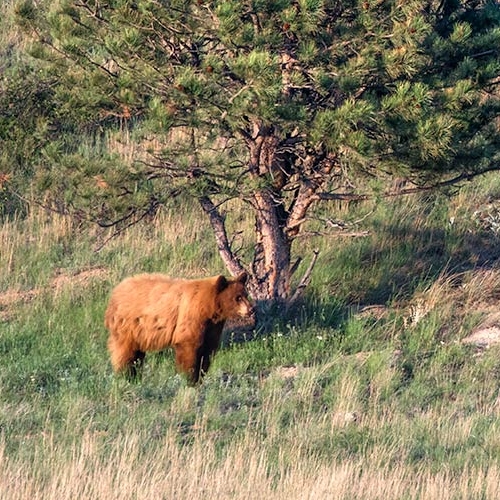A few weeks ago I was a guest on the Coffee Ranch near Garland, Montana. One of its owners, Bill Coffee, showed me around his ranch and of course I had my trusty camera in tow. He was telling me the story of bear on the property. He said he thought it was a black bear, though it was brown. Knowing exactly what breed it is would be important information, especially given the fact that brown bears (or grizzly bears) are much more dangerous than black bears.
An hour or two later while driving across his "back 40" Bill asked me, "Is that a bear over there?" It was far away and at first glance I thought it was a tree stump. I pulled out my 400mm lens. My telephoto lens could barely reach the bear, but I was using a 50 megapixel camera so I could zoom in when I got home. And sure enough...it was a damn brown colored bear.
I've been making photos of Montana long time and I have yet to lay eyes on a brown bear. This was my first But was it really a brown bear? I mean, it was colored brown, but its features were much more like those of a black bear. What's the story?
I remember hearing the story of a hunter who hired an aboriginal guide in the Northwest Territory of Canada to go hunting for polar bears. The guide spotted a bear, told the man to shoot, and he did. And he bagged a bear. But under closer inspection it was not a polar bear. While it shared some of the features of a polar bear, it has patched of brown hair. It was later determined that it was the offspring of a brown bear and a polar bear...never before seen.
That story made me wonder if a black bear and a brown bear could breed. So I did a little research. In 1859 a black bear and European brown bear were bred together in the London Zoological Gardens. Called "ursid hybrids," three offspring did not reach maturity. There does not appear to be an example of an American brown bear or black bear ever having successful mated. So that possibility seems far fetched.
That said, I did learn that in addition to black (of course) black bears can be blue-black, dark brown, brown, cinnamon and even white. Given how far Garland, Montana in Custer County is to any known brown bear or grizzly bears I assume what I photographed was in fact a black bear. If not, it would be quite a story.






